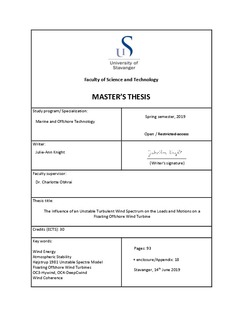| dc.contributor.advisor | Obhrai, Charlotte | |
| dc.contributor.author | Knight, Julie-Ann | |
| dc.date.accessioned | 2019-10-09T07:48:01Z | |
| dc.date.available | 2019-10-09T07:48:01Z | |
| dc.date.issued | 2019-06 | |
| dc.identifier.uri | http://hdl.handle.net/11250/2621066 | |
| dc.description | Master's thesis in Offshore Technology : Subsea technology | nb_NO |
| dc.description.abstract | Floating offshore wind turbines are exposed to harsh environmental conditions throughout their lifetime and typically experience unstable atmospheric conditions. Including the effect of atmospheric stability should improve the accuracy of fatigue load calculations, and subsequently, the design of the wind turbine. The objective of this study is to investigate the influence of different unstable turbulent wind fields on the loads and motions on a floating offshore wind turbine (FOWT), with emphasis on Højstrup’s 1981 Unstable Spectra Model. The turbulent wind fields were generated using the spectral representation approach by Shinozuka and Deodatis [1992], and then used within SIMA to simulate the fatigue and motions on a FOWT. The resulting fatigue loads and platform motions were analyzed under varying stability and varying coherence for both the OC3-Hywind spar-buoy FOWT and the OC4-DeepCwind semisubmersible FOWT. The most significant difference between the simulated wind fields was found for the tower top torsion fatigue load, where very unstable conditions were 47% larger than neutral conditions for the OC3-Hywind FOWT and 30.4% larger for the OC4-DeepCwind FOWT. Since very unstable conditions corresponded to the highest turbulence intensities and largest turbulent fluctuations, they consequently resulted in larger fatigue loads for the tower top torsion. Other modes, such as the blade root flap-wise and tower base fore-aft bending moments, were relatively unaffected.
Unlike the notable differences seen when simulating unstable conditions, the sensitivity study for variations in lateral and vertical coherence showed less variability and little consequence on a majority of the platform modes. However, a variation in vertical coherence resulted in fatigue loads for the blade root-flap wise moment that were 16.25% (OC3) and 38.8% (OC4) larger under a more coherent wind field, while a variation in lateral coherence gave fatigue loads for tower top torsion that were 13.4% (OC3) and 20.7% (OC4) larger under a less coherent wind field. Overall, one can conclude that the additional low frequency turbulent behavior, associated with unstable conditions, increased the turbulent fluctuations and therefore, was of more importance than changes in wind coherence for this study.
In addition to assessing the influence of stability and coherence on a FOWT, the results were compared to the findings of Putri [2016]. The goal of the comparison was to see if more realistic turbulence intensities, and hence damage equivalent loads, could be simulated under unstable atmospheric conditions using Højstrup’s 1981 Unstable Spectra Model. In contrast to the Højstrup model, the fitted Mann model, used within that study, does not account for buoyancy generated turbulence. This difference could explain why Putri [2016] found higher turbulence values and therefore, larger fatigue loads under neutral atmospheric stability conditions. Nonetheless, further analysis should be conducted to improve the Højstrup model in order to better depict unstable conditions in an offshore environment. | nb_NO |
| dc.language.iso | eng | nb_NO |
| dc.publisher | University of Stavanger, Norway | nb_NO |
| dc.relation.ispartofseries | Masteroppgave/UIS-TN-IMBM/2019; | |
| dc.rights | Navngivelse 4.0 Internasjonal | * |
| dc.rights.uri | http://creativecommons.org/licenses/by/4.0/deed.no | * |
| dc.subject | offshore teknologi | nb_NO |
| dc.subject | wind energy | nb_NO |
| dc.subject | atmospheric stability | nb_NO |
| dc.subject | Højstrup 1981 Unstable Spectra Model | nb_NO |
| dc.subject | OC3-Hywind | nb_NO |
| dc.subject | OC4-DeepCwind | nb_NO |
| dc.subject | wind coherence | nb_NO |
| dc.subject | vindkraft | nb_NO |
| dc.subject | floating offshore wind turbines | nb_NO |
| dc.subject | vindturbiner | nb_NO |
| dc.subject | undervannsteknologi | nb_NO |
| dc.title | The Influence of an Unstable Turbulent Wind Spectrum on the Loads and Motions on a Floating Offshore Wind Turbine | nb_NO |
| dc.type | Master thesis | nb_NO |
| dc.subject.nsi | VDP::Technology: 500::Marine technology: 580::Offshore technology: 581 | nb_NO |

